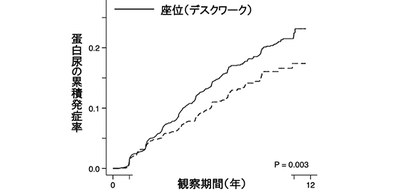
Retrospective cohort study for workers at Osaka University: Male sedentary workers are at high risk of proteinuria
A group of researchers from the Health and Counseling Center and the Graduate School of Medicine at Osaka University performed a retrospective cohort study that included 10,212 workers at a national university, clarifying that male sedentary workers were at high risk of proteinuria.
The number of chronic dialysis patients in Japan is about 340,000 as of the end of 2018 and is still on the rise, and the annual medical costs of dialysis treatment in Japan is estimated at about 1.6 trillion yen (about 4% of the total medical costs). In order to reduce the number of chronic dialysis patients and medical costs, it is necessary to establish preventive measures for chronic kidney disease (CKD), a condition characterized by proteinuria and a gradual loss of kidney function over time, namely a decreased glomerular filtration rate (GFR), and it is important to identify lifestyle risk factors of CKD, such as obesity and smoking.
Although long sedentary work has a risk of developing lifestyle related diseases (such as metabolic syndrome, diabetes, and cardiovascular diseases) and mortality, little information was available about the clinical impact of occupational sedentary behavior on CKD.
This group evaluated how sedentary work affects the development of proteinuria for 10,212 workers at Osaka University who underwent annual health checkups between April 2006 and March 2013.
In 3,449 men who self-reported that they had occupational sedentary behavior at the baseline visit, during a median observational period of 4.8 years, the incidence of proteinuria, defined as dipstick urinary protein of 1 + or more, was 452 (13.1%). On the other hand, in 1,538 men who reported that their main occupational activity was standing, walking, carrying, or heavy labor at the baseline visit, the incidence of proteinuria was observed in 145 men (9.4%).
After performing multiple classification analyses, the incidence of proteinuria observed in male sedentary workers, which is identified as a significant predictor of the incidence of proteinuria, was 1.35 [1.11–1.63]) (95% confidence interval).
CKD characterized by proteinuria is also a predictor of future decline in GFR. This study clarified that male sedentary workers are at high risk of developing kidney diseases. However, in females, neither sedentary workers nor television viewing time was associated with the incidence of proteinuria.
This study shows that sedentary behavior is a risk factor of proteinuria. Reducing occupational sedentary behavior could reduce the risk of developing CDK. It is necessary to further study and verify the association occupational sedentary behavior with proteinuria in the wider scope of job categories.
Figure 1
The article, “Occupational sedentary behavior and prediction of proteinuria in young to middle-aged adults: a retrospective cohort study,” was published in Journal of Nephrology at DOI: 10.1007/s40620-020-00826-w.
